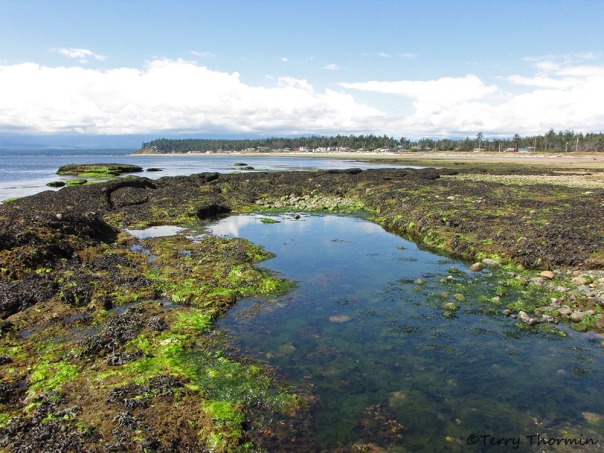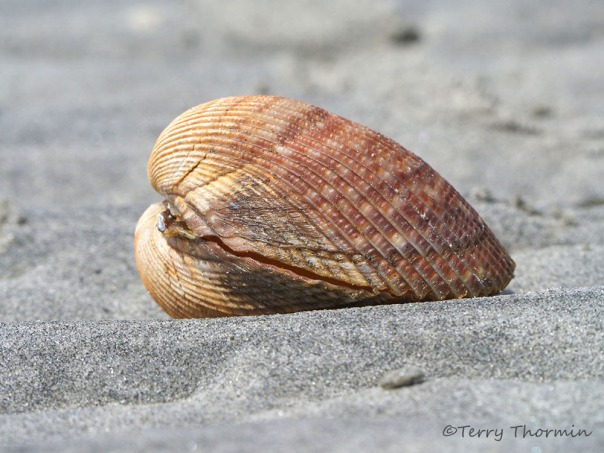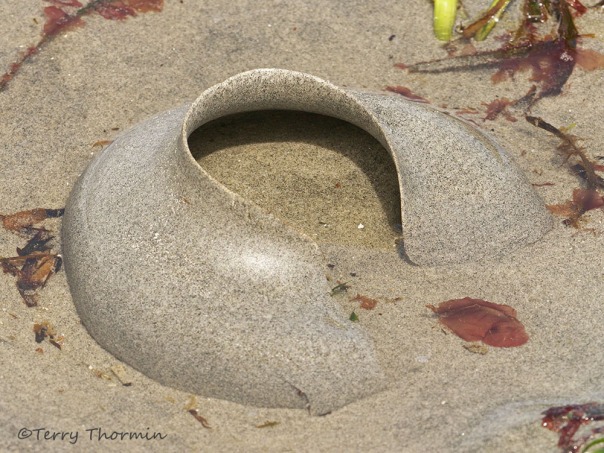Intertidal Life – Terry Thormin
Three years ago I moved from the prairies of central Canada (Edmonton, Alberta to be precise) to Comox, Vancouver Island. Until that time I had lived all my life inland, and now here I was on the coast. So much is new here that I doubt that I will ever run out of things to do and places to go. Perhaps the most fascinating habitat though, and the one that I have devoted the least amount of time to, is the intertidal zone, that area exposed when the tide goes out. At low tide the rocky shoreline, sandy or muddy tide flats, and in some areas tide pools are accessible. For those willing to take the time there is a wealth of wildlife here.
Whenever I visit this habitat, especially in summer, there are people out on the exposed beaches. Some are walking their dogs or out for a stroll or just sitting in their camp chairs, reading or sunning themselves. Some, however, especially parents with young children, are actually exploring, looking in tide pools and turning over rocks. But this seems to be largely the pastime of the children, and not the adults. I remember as a child when the family went to Cape Cod to visit our relatives, how much I looked forward to exploring the same way. Fortunately I have not lost that sense of curiosity, and I still enjoy doing the same thing, but now I also want to put a name to everything and learn something about the various things I find. And of course I am always taking photos.
So to start with here is a photo of the closest tidepools to where I live, a short 5 minute drive away, followed by photos of some of the various creatures from previous visits to the intertidal zones with some information on each one.
When I think of Pacific tide pools the first thing I think of is anemones, so I will start with the Giant Green Anemone. Although quite common in tidepools this anemone can be found as deep as 15+ m (50 ‘). It can grow as large as 30 cm (12”) and can live for up to 30 years in captivity. Like all anemones it has stinging nematocysts on the tentacles and it feeds on small fish, crabs, sea urchins and shrimp. The green colour of this species is the result of having green algae growing in the tentacles. I have found this species to be more common on the west coast of the island.
The next creatures I think of in tide pools are the sea stars. The first I will mention is the Purple Star. This species is quite common on the east coast of Vancouver Island where I live. Although most commonly found in tide pools, I have also seen it in rocky beaches and lines of kelp. It can also be found in much deeper water, up to 90 m (300 ‘). It feeds on a variety of molluscs including mussels, chiton, abalone and a various snails. Its bright purple colour with a delicate, filigree pattern in white makes it one of the most attractive of sea stars. Although less commonly seen, at least in my experience, it also can be found in shades of brown, yellow and orange.
Another sea star that I see occasionally is the Sunflower Star. This is the largest of the sea stars in my area, getting up to 1 m (39“) across. Evidently juveniles of this species start with 5 arms, but gradually add more as they get older, getting up to 24 arms as adults. If they lose an arm to a predator, it will gradually grow back. In this photo you can see where this individual lost an arm and it is now growing back. Although it is occasionally found in tide pools, on rocky shorelines and even sandy beaches, it can also be found at depths up to 435 m (1,435’). It is one of the fastest moving sea stars and will crawl or even swim quickly to avoid predators such as abalone and swimming scallops.
The next creature is Nuttall’s Cockle, a bivalve mollusk that can be found on sandy or gravel shorelines and to a depth of 30 m (100’). Large individuals can get up to 14 cm (5 ½”) across. When viewed from the side it has a distinctive heart-shaped cross-section, resulting in its alternate name the heart cockle. One of its chief predators is the Sunflower Star, and when threatened by the star it used its long, powerful foot to vigorously push off from the star and hopefully escaping.
My next object is not a creature, but rather an artifact left behind by a creature. It is the Moon Snail sand collar. Sand collars are quite large and distinctive, and thus usually quite visible in sandy intertidal areas. The shape of the collar is dictated by the curve of the snail shell. Inside the collar is a layer of jelly containing the eggs of the snail, and this is sandwiched between two layers of sand held together by mucus. The snails lay their eggs seasonally from April to September with the peak being May and June.
My final creature is the Kelp Isopod, or Vosnesensky’s Isopod. This creature is the marine equivalent of the sowbugs and pillbugs. There are far more marine isopods than terrestrial however, and in fact some 4,500 species have been described worldwide. This is a large species, getting up to 3.6 cm (1.4”) and is most likely to be seen in lines of beached kelp and other seaweed. It can also be found in waters up to 15 m (50’) in mussel beds and hiding under rocks.
This is barely scratching the surface of the diversity of creatures that can be found in the intertidal area. Hopefully I will be able to cover more of these fascinating creatures in future posts. Who knows, maybe these blogs will inspire some other people to take the time to look for some of these fascinating creatures. A search in your local bookstore and library will turn up a wealth of books on the subject, so identifying and learning more about these creatures should be easy. Take the time to search the sandy and rocky beaches. Take the time to look carefully in the tide pools. There are many amazing and beautiful creatures here, and maybe it will reawaken that sense of curiosity and wonder that you lost when you grew into adulthood.
And one final word, if you have never read “The Edge of the Sea” by Rachel Carson, or like me haven’t read it for many years, then pick it up and read it now. It is truly a timeless classic which I am thoroughly enjoying reading for a second time.
Posted on September 21, 2012, in environment, Marine life, Nature and tagged anemones, behavior, Biodiversity, Intertidal, molluscs, photos, sea stars, tide pools. Bookmark the permalink. 4 Comments.









Reminds me of a great field trip to Bamfield Marine Station when I took Richard Palmer’s Invert. Diversity course at the U of A. How I envy your location!
Absolutely beautiful, thanks for sharing.
I used to get to occasionally enjoy the natural beauty of Pedder Bay when I visited my BF. That was til all the residents were turfed 2 or 3 years ago – corporate corruption is alive and well; the eviction of the Pedder Bay residents was a tragedy.
(Please, not to go negative here, I just don’t want people to forget – the tenants fought in part to help preserve the bay)
Seeing this photo took me right back to my morning views there.
(it was a former co-worker/friend who recommended your site)
Cheers to all!
Absolutely beautiful images of wondrous creatures — I was raised in the South Pacific, and it’s fascinating to see them, just a bit differently. 🙂 You’re now in my favorite place on the planet — I can’t wait to see what more you have to post!
Great photos and the text is informative. Reminds me of my last trip to Victoria.